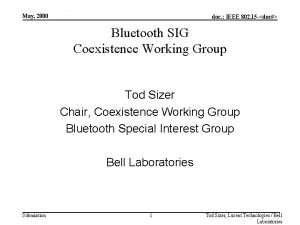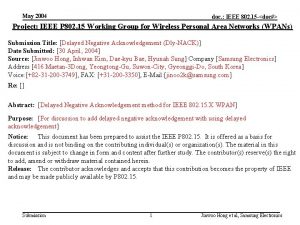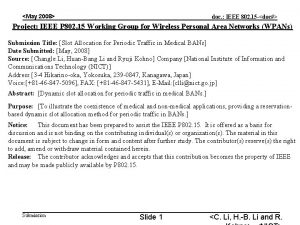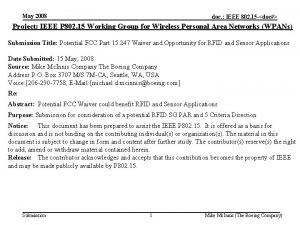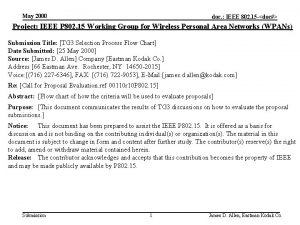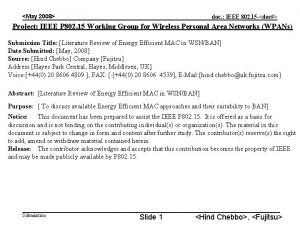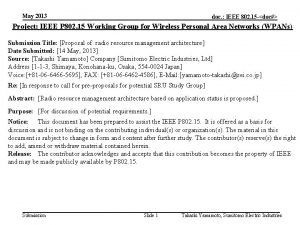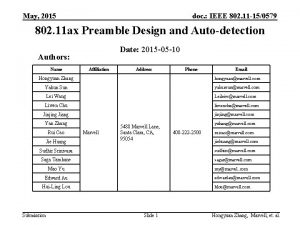May 2016 doc IEEE 802 11 160700 r












- Slides: 12

May 2016 doc. : IEEE 802. 11 -16/0700 r 0 Antenna Polarization and Beamforming for 11 ay Date: 2016 -05 -16 Authors: Submission Slide 1 James Wang, Mediatek

May 2016 doc. : IEEE 802. 11 -16/0700 r 0 Introduction • Multiple antenna polarizations is an attractive way for small devices with limited space to realize diversity and MIMO • Due to propagation characteristics of mm. Wave, antenna polarization can affect the performance significantly • if polarization is misaligned, it affecting end-to-end performance significantly (i. e. , signal drops due to polarization misalignment, cross -polarization interference rises) • Antenna polarization can support MIMO spatial multiplexing. • 11 ay should adopt more powerful and efficient method to deal with the effects of polarization for ensuring reliable performance • Potential simplification in BF training for antenna polarization by exploiting the high correlation between the ray-tracing path of the multiple polarizations Submission 2 James Wang, Mediatek

May 2016 doc. : IEEE 802. 11 -16/0700 r 0 Basic Types of Antenna Polarization • Types of antenna polarization • Linear polarization • Circular polarization • Mixed polarization • There are three possible orthogonal polarizations (e. g, x, y, z directions) • In general, the polarization direction is described by unit vector or euler angle (α, β, γ) relative to a coordinate system • Depending on antenna axial ratio, orientation, and propagation, the cross-polarization alignment loss (provided in backup charts) can be significant. Submission 3 James Wang, Mediatek

May 2016 doc. : IEEE 802. 11 -16/0700 r 0 Polarization Implementations • Two types of polarization implementation • Separate antennas for different polarizations (e. g. , one antenna vertical, one antenna horizontal) • Same antenna with multiple polarizations (e. g. , one physical antenna with multiple polarization ports) • In general, the former type can be treated as separate antennas • The latter type can also be used to synthesize different antenna polarization: Inclined Linear (θ 1= θ 2 G 1/G 2) or Circular • Polarization rotation (i. e. to change angle of inclination for TX/RX polarization alignment) • Linear to circular polarization conversion or vice versa Submission 4 (θ 1=θ 2 +/-90 deg, G 1=G 2) G 1 θ 1 G 2 θ 2 ⁺ James Wang, Mediatek

May 2016 doc. : IEEE 802. 11 -16/0700 r 0 Example Antenna Polarization BF Training • As a first step, antenna type and capability needs to be known to both sides. • TX polarization BF training can be simplified by • Step 0: Indicate antenna polarization type/capability during initial Capability Exchange • Step 1: complete SLS with one of the polarization or with synthesized polarization • Step 2: Feedback some selected some sectors/antennas & request specific polarization training on selected sectors/antennas • Step 3: Additional training frame/fields for the Polarization training on the selected antenna sectors/antennas • Step 4: feedback the final selection of sector/antenna/polarization Submission 5 James Wang, Mediatek

May 2016 doc. : IEEE 802. 11 -16/0700 r 0 Example of Polarization BF Training • Step 1 transmitter uses synthesized circular polarization to train a linear polarization receiver • Note circular polarization allows a linear polarized receiver to receive (3 d. B loss) without antenna alignment • Step 3 transmitter trains its linear polarization inclination • Align linear polarization to enhance SNR TX Step 1 Step 3 RX Submission 6 James Wang, Mediatek

May 2016 doc. : IEEE 802. 11 -16/0700 r 0 Polarization Type/Capability • Antenna polarization capability information to be considered • Basic polarization types • linear, • circular, • mixed • Polarization switch • Polarization MIMO • Synthesizable polarization • linear (adjustable inclination) • circular (RH, LH) • mixed polarization (RH, LH, adjustable inclination & eccentricity)) Submission 7 James Wang, Mediatek

May 2016 doc. : IEEE 802. 11 -16/0700 r 0 Conclusions • 11 ay should enable more powerful and efficient method to deal with antenna polarization for enhanced performance • Propose, as a first step, to explicitly exchange information about antenna polarization types/capability • Allowing both sides to know the polarization type/capability • Enabling further development of more efficient or powerful BF Training protocol for antenna polarizations Submission 8 James Wang, Mediatek

May 2016 doc. : IEEE 802. 11 -16/0700 r 0 Straw Poll 1 • Move to include the antenna polarization capability information in the 11 ay capability exchange. (Capability information is TBD) • Yes • No • Abstain Submission 9 James Wang, Mediatek

May 2016 doc. : IEEE 802. 11 -16/0700 r 0 Backup Charts Submission 10 James Wang, Mediatek

May 2016 doc. : IEEE 802. 11 -16/0700 r 0 Polarization Misalignment • The received power is affected by the misalignment in TX and RX antenna polarization, if only single polarization is used in TX and/or RX. • Received power loss due to misalignment of the two linear polarizations: • Received power loss due to misalignment one linear polarization and one circular polarization • Note that SIMO or MIMO RX with dual polarization will not have misalignment loss. Submission 11 James Wang, Mediatek

May 2016 doc. : IEEE 802. 11 -16/0700 r 0 Polarization Misalignment • Received power loss due to misalignment of the two circular polarizations: • Received power loss due to misalignment of the two elliptical polarizations: Submission 12 James Wang, Mediatek













